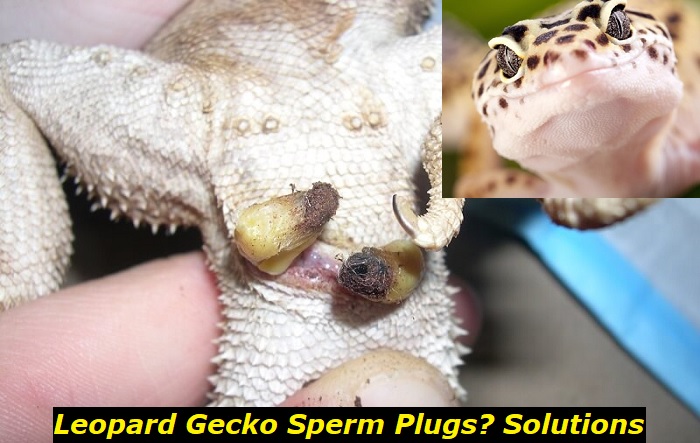Seminal plugs or sperm plugs can start as a harmless build-up but later lead to complications and even more severe health issues.
Often they are confused for dried-off fecal matter, but that is wrong. Sperm plugs usually grow deep into the hemipenes of your pet. Are you wondering what to do about your leopard gecko’s sperm plug?

Check this explanatory article to understand what sperm plugs in leopard geckos are, how they come about, and your options to help your pet get out of trouble.
Read on to find out!
What Is Leopard Gecko Sperm Plug?
Sperm plugs in leopard geckos are also known as seminal plugs in leopard geckos. They are solidified and compact waxy plugs that develop from within the inverted hemipenes. It is usually a build-up of sperm and dead skin cells, otherwise called cellular debris.
Males usually have two separate bulges just behind their vents. These bulges appear underside on both sides under the tail. These bulges are where the hemipenes are found, and it is from within these hemipenes that the sperm plug builds up.
The outer part is capped with small clumps of feces which is how you tell its presence. But the sperm plug is usually long with a diminishing shape. It will usually have a somewhat spherical cap at the end close to the vent.
The sperm plug is normally expelled when your leopard gecko passes out feces. But the sperm plug can become a problem when you find them extending from within the hemipenes into the vent thereby becoming very visible.
When this happens, feces along the top of the sperm plug usually coat the top end, and this is a sign that you need to do something about the sperm plug before it does something bad to your leopard gecko.
Many inexperienced leopard gecko keepers often mistake the fecal coating on top of the retained sperm plug for a clump of fecal matter lingering in the vent. But in reality, that top coating is just the top of the sperm plug.
Sperm or seminal plugs usually form in leopard geckos during the mating season as it serves reproduction purposes. Naturally, your leopard gecko should expel the sperm plug when it passes out feces.
You may not notice these sperm plugs as they are often expelled when very small. Sometimes, they may be passed out with feces such that they are covered in fecal matter.
But when your leopard gecko fails to expel the sperm plug naturally, it will continue to grow. This will become a problem for your leopard gecko because the growth of the sperm plug takes place within the hemipenes.
Your leopard gecko will suffer severe discomfort in the long run, to say the least. In some other extreme cases, the consequences may become fatal.
Can I Remove the Sperm Plug for My Leopard Gecko?
Yes, you can, but you should enlist the help of a herp veterinarian if you have not done it before, think you cannot do it, or your leopard gecko’s personality makes you believe it might drop its tail if you handle him for too long.
This is important because a herp veterinarian has more knowledge about leopard geckos and how best to handle this situation.
Sometimes, when treating leopard geckos that do not like being handled, herp vets administer some anesthetics. They do this to keep your pet stable while they remove the sperm plug.
But this will depend entirely on your leopard gecko’s personality and the herp vet’s decision.
You can tell that your leopard gecko needs your intervention when you begin to notice the top of the sperm plug trapping feces. With further inspection, you should find stiffened smooth fecal matter in your leopard gecko’s vent.
If you choose to remove them yourself, it would be ideal to start with a soak. You want to treat your leopard gecko to a warm bath. The goal of the bathe is to soften the hard sperm plug. After the bath, you want to rock the sperm plug gently from side to side.
You will need some facial tissues, a Q tip, or a regular cotton bud. If you are using the Q tip or cotton bud, it would be best to occasionally dip them into warm water to soften the buds.
But this will not be necessary if you are using facial tissues because they have some moisture in them already.
Rock the sperm plug gently to dislodge and remove it. Give it a little pull with the bud or the facial tissue as you rock it. The sperm plug should come off ideally.
You may notice a bit of the seminal plug remains inside the hemipenis. That should not bother you because the hemipenis will retract back into the tail.
There may be another seminal plug in the second hemipenis; remember that leopard geckos have two hemipenes or penises.
Inspect it for a sperm plug and repeat the process to remove it.
Dealing With a Restless Leopard Gecko?
If your leopard gecko does not like being handled at all and you fear that he might drop his tail if the pain makes him think he is in danger, there are other things you can do to handle the situation before removing the sperm plug.
You can do what the vet would do if you took your pet to the vet. You will need to start with a sedative to make your leopard gecko relaxed. You can use regular anesthetic. This will ensure that your leopard gecko does not feel any pain during the procedure.
You can sedate your leopard gecko with injectable hydromorphone and alfaxalone. After that, you want to rock the sperm plug gently from side to side, as described above. Check for any sperm plug in the second hemipenis and remove it if there is one.
Your leopard gecko may end up bleeding after the procedure. You want to clean the slight bleeding with some cotton bud. You can clean up the wound with dilute betadine.
You want to apply some Silvadene cream after stopping the bleeding.
End the procedure by applying some anti-inflammatory medication. One good option you can use is Meloxicam. This is pretty much all that the vet will do if your leopard gecko does not like being handled.
This is a better approach because there is a chance that he might separate his tail if he fears that he is in danger.
Tip: Note that seminal plug build-ups are easier to remove when noticed early. You must monitor your lizard closely, especially during and after mating season. In the wild, they will naturally get rid of it as they scratch it against surfaces. But the conducive nature of the enclosure makes it almost impossible for them to expel it on their own.
Ensure to practice proper animal husbandry. Improper husbandry practice, such as lack of the appropriate humidity level is one of the common reasons leopard geckos are predisposed to this condition.
You will often find dead skin cells attached to the sperm plugs because the humidity level was too low for them to shed properly.
You also want to ensure that an appropriate humidity level is maintained in their enclosure. Leopard geckos need about 30-40% humidity.
Note
You must discuss the condition of your leopard gecko with your vet. Some vets may be unfamiliar with how seminal plugs work. This may be a result of not keeping up with the current research and literature about reptile veterinary practices.
No matter how many years of practice the vet may have, he may wrongly amputate your pet’s hemipenes because he does not have an understanding of what the problem is. You want to discuss and engage your vet to be sure that he is updated about the current research and practice of herp veterinary practices to avoid a wrong and needless procedure.
Bottom Line
There is a risk of letting the sperm plug grow too big. The seminal plug is a build-up of dead cells and dried seminal fluid. If you do not remove it on time, it will continue to grow until it makes your leopard gecko uncomfortable.
In severe cases, it may lead to more severe health complications. You want to remember that your pet does not urinate from the hemipenes. Those two phalluses have only one job; reproduction only. So it would be best to remove it as soon as you notice the build-up.
A final warning if you must remove it by yourself is to remember that your pet will be exposed to the risk of an infection if you do not treat the minor bleeding well.
Ensure to treat any open with the appropriate medication so that there are no complications or infections. Use the right medical products.
If you think you cannot handle the procedure, you can book an appointment with a vet to help your leopard gecko remove the seminal plug.
- Dubia Roach Egg Sack: How To Understand if It’s Healthy? - January 2, 2023
- How To Feed African Dwarf Frog While on Vacation? - December 26, 2022
- Baytril for Bearded Dragon: Here’s What You Should Know - December 19, 2022



